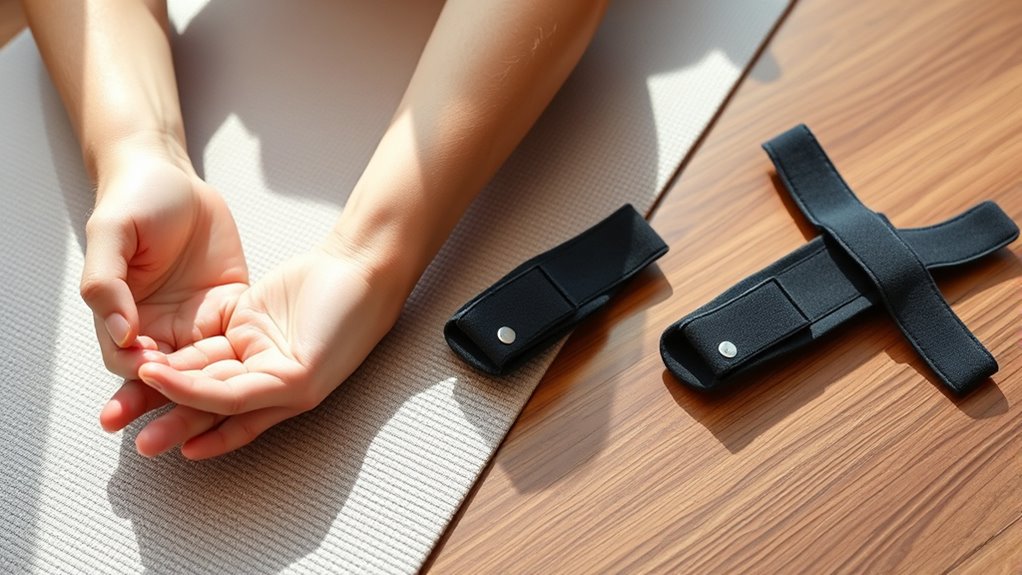To combat wrist pain, focus on gentle stretching exercises like wrist flexor and extensor stretches to improve flexibility and relieve tension. Incorporate strength-building workouts to support your wrists and prevent future issues. Use supportive gear such as braces or compression sleeves for added stability, especially during repetitive tasks. Also, optimize your workspace ergonomically to reduce strain. Keep progressing with these tips—more strategies await to help you find lasting relief.
Key Takeaways
- Perform wrist stretching exercises like flexor and extensor stretches to improve flexibility and reduce tension.
- Incorporate gentle wrist rotations and massage to enhance circulation and prevent stiffness.
- Use wrist supports or braces, such as compression sleeves or rigid braces, to stabilize and protect the joint.
- Maintain ergonomic workspace setup with proper keyboard, mouse positioning, and adjustable furniture to reduce strain.
- Regularly strengthen wrist muscles through targeted exercises and take breaks to prevent repetitive strain injuries.
Understanding Wrist Pain and Its Causes

Wrist pain can stem from a variety of causes, and understanding them is key to effective treatment. One common source is carpal tunnel syndrome, which occurs when the median nerve gets compressed within the wrist’s narrow passageway. To grasp this better, you need to know your wrist anatomy: it consists of bones, ligaments, tendons, and nerves that work together to allow movement and sensation. When this structure is compromised—due to repetitive motions, swelling, or injury—you might experience pain, numbness, or weakness. Recognizing the signs and understanding how your wrist’s complex anatomy functions can help you identify issues early. Proper awareness is vital for preventing further damage and seeking targeted treatment for your wrist pain.
Effective Stretching Exercises for Wrist Relief

Incorporating wrist stretches can markedly reduce pain and improve mobility. Focus on wrist flexor stretches, extensor techniques, and gentle range-of-motion movements to target different areas. These exercises are simple to do and can be integrated into your daily routine for lasting relief. Using appropriate headphone jacks can also help prevent unnecessary strain during extended use, promoting better ergonomic habits.
Wrist Flexor Stretches
When your wrists feel tense or sore, stretching the flexor muscles can provide significant relief. Wrist flexor stretches target the muscles on the inside of your forearm, helping improve forearm mobility and reduce strain. To perform this stretch, extend one arm in front of you with your palm facing up. Use your opposite hand to gently pull your fingers back toward your body, feeling a stretch along your forearm. Hold for 15-30 seconds, then switch sides. Keep your elbow straight and avoid bouncing. Regularly practicing wrist flexor stretches can loosen tight muscles, decrease pain, and enhance your wrist’s range of motion. Incorporating proper technique into your routine can maximize benefits and prevent injury. Incorporate these stretches into your daily routine to help prevent future discomfort and support overall wrist health.
Extensor Stretch Techniques
If your forearm muscles feel tight or sore, stretching the extensors can provide quick relief and improve wrist flexibility. The wrist anatomy includes the extensor muscles along the back of your forearm, which help lift and extend your wrist. Tight extensors may contribute to nerve impingement, causing pain or tingling sensations. To stretch these muscles, extend your arm with your palm facing down. Use your opposite hand to gently pull your fingers back toward your forearm, feeling a stretch along your wrist and forearm. Hold for 15-30 seconds and repeat several times. This targeted stretch relaxes the extensor muscles, alleviates tension, and can reduce nerve impingement symptoms, easing wrist pain and enhancing mobility. Incorporating exercise routines focused on wrist flexibility can further support recovery and prevent future discomfort.
Gentle Range Movements
Gentle range movements are an effective way to improve wrist flexibility and reduce pain without straining your muscles. Incorporate wrist yoga poses to gently stretch your wrists and maintain mobility. These movements help increase blood flow and loosen tight tendons, alleviating discomfort. A simple exercise is to gently rotate your wrists clockwise and counterclockwise, feeling the stretch in your forearms. You can also perform hand massage techniques to relax muscles and improve circulation, which complements your stretching routine. Focus on slow, controlled movements, avoiding any pain or resistance. Regularly practicing these gentle range movements can help prevent stiffness and improve wrist function over time. Additionally, paying attention to proper exercise techniques can maximize benefits and minimize risk of injury. Remember, consistency is key to gaining lasting relief from wrist pain.
Strengthening Workouts to Support Your Wrists

Building wrist strength is essential for reducing pain and preventing injury, especially if you perform repetitive motions or engage in weight-bearing activities. Focus on exercises that enhance wrist mobility and grip strength to create a solid foundation. Strengthening your wrists helps you move with confidence and resilience, reducing the risk of setbacks. Incorporating exfoliation benefits into your routine can also improve skin health around your wrists, making them less prone to irritation. Feel the power grow as your grip tightens, giving you control and confidence. Experience the freedom of fluid wrist mobility, easing everyday tasks. Watch your pain fade as your muscles strengthen and stabilize. Reclaim your activity level and push beyond previous limits with strengthened wrists.
Choosing the Right Wrist Supports and Braces

Choosing the right wrist supports and braces can make a significant difference in managing pain and preventing injury during activity or recovery. There are various brace types designed for different needs, such as compression sleeves, rigid braces, and adjustable wraps. Your choice depends on your specific condition and activity level. Support sizing is essential; a brace that’s too tight can restrict circulation, while one that’s too loose won’t provide adequate stability. Always measure your wrist accurately and follow manufacturer sizing guides. Consider how much support you need—light compression for slight discomfort or rigid support for more serious injuries. Properly fitted braces can reduce strain, improve alignment, and help you stay active while protecting your wrists effectively. Additionally, understanding skin health can aid in selecting supports that won’t cause irritation or adverse reactions.
Tips for Preventing Future Wrist Discomfort

To prevent future wrist discomfort, focus on maintaining proper ergonomics at your workspace. Make sure your keyboard and mouse are positioned to keep your wrists straight and supported. Additionally, remember to stretch your wrists regularly during tasks to reduce strain and promote flexibility. Incorporating ergonomic furniture can further enhance comfort and reduce the risk of discomfort.
Proper Ergonomics at Work
Since poor ergonomics can lead to wrist strain over time, establishing proper workstation setup is essential. Using wrist-friendly keyboards helps keep your wrists in a neutral position, preventing unnecessary strain. Adjust your chair and monitor height to maintain a comfortable posture and avoid reaching or hunching. Remember, small changes can make a big difference in preventing future discomfort. Incorporating vertical storage solutions can help keep your workspace organized and reduce clutter that might contribute to poor posture.
Stretch Regularly During Tasks
Regular stretching during tasks can considerably reduce wrist tension and prevent discomfort from developing over time. Take brief breaks to perform simple hand massage techniques, which promote wrist relaxation and ease tightness. Stretch your fingers wide, then gently flex and extend your wrists to maintain flexibility. Incorporate wrist rolls or circles to loosen up the joint and improve circulation. When feeling tension, apply gentle pressure with your opposite hand to massage the forearm and wrist area. These small, frequent stretches and massages help prevent strain from repetitive movements and keep your wrist muscles supple. Consistently prioritizing wrist relaxation during work not only reduces immediate discomfort but also minimizes the risk of chronic wrist pain, supporting long-term comfort and function.
When to Seek Professional Help for Wrist Issues

You should see a healthcare professional if wrist pain persists beyond a few days, worsens despite rest, or is accompanied by swelling, numbness, or weakness. Ignoring these signs can lead to long-term damage. Seek help promptly to explore effective treatments, including alternative therapies like physical therapy or ergonomic adjustments. If conservative methods don’t provide relief, your doctor may recommend surgical options to restore function. Don’t delay if your pain interferes with daily activities or worsens over time. Early intervention can prevent chronic issues and improve outcomes. Remember, wrist problems aren’t just minor annoyances—they could be signs of underlying conditions needing professional care. Your health is worth prioritizing, so trust your instincts and seek help when necessary. Additionally, understanding family photoshoot fails can help you recognize the importance of proper care and preparation for wrist injuries.
Frequently Asked Questions
Can Wrist Exercises Worsen Existing Pain?
Wrist exercises can worsen existing pain if you’re not careful. Gentle stretches can help improve flexibility, but aggressive stretching might strain your wrist further. Similarly, strengthening exercises should be done gradually; pushing too hard too soon can cause setbacks. Listen to your body and differentiate between gentle and aggressive movements. Always consult a healthcare professional before starting new exercises to avoid aggravating your wrist pain.
Are There Specific Exercises for Rheumatoid Arthritis Wrist Pain?
You’re wondering if specific exercises can help with rheumatoid arthritis wrist pain. Incorporate gentle stretching routines, focus on improving joint mobility, and avoid overstretching that causes discomfort. Try wrist circles, finger stretches, and gentle flexion and extension exercises to keep your joints active and reduce stiffness. Always listen to your body, and consult your healthcare provider before starting new routines to guarantee they’re safe and effective for your condition.
How Often Should I Wear Wrist Braces During Activities?
You should wear a wrist brace during activities that put strain on your wrists for activity specific support. The wrist brace frequency depends on your pain level and activity, but generally, it’s best to wear it during strenuous tasks and remove it during rest. Always follow your healthcare provider’s advice to avoid over-reliance. Proper use guarantees better wrist stability and helps prevent further discomfort or injury.
What Are the Best Ergonomic Setups to Prevent Wrist Strain?
You should prioritize ergonomic setups to prevent wrist strain. Use an ergonomic keyboard that encourages natural hand positioning and reduces tension, and incorporate wrist support pads to cushion your wrists during prolonged tasks. Adjust your desk and chair height so your wrists stay straight and relaxed while typing. Regular breaks and stretching also help. These strategies work together to minimize discomfort and promote healthier wrist habits.
Do Dietary Changes Affect Wrist Pain Management?
Wondering if your diet can diminish wrist pain? You bet! Incorporate anti-inflammatory foods like berries, leafy greens, and fatty fish to soothe soreness. Nutritional supplements such as omega-3s and turmeric can also help reduce inflammation. By making mindful modifications to your meals, you support your body’s natural healing processes, potentially alleviating wrist discomfort and enhancing overall wellness. Small dietary changes can make a significant, soothing difference.
Conclusion
By incorporating these exercises, choosing the right gear, and practicing good habits, you can keep your wrists healthy and pain-free. Remember, taking small steps today can prevent bigger problems tomorrow. So, why wait until discomfort becomes a real issue? Stay proactive, listen to your body, and give your wrists the care they deserve. After all, isn’t a little effort now worth a lifetime of comfort?









